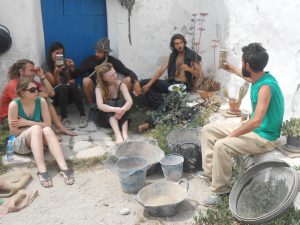Eco Construction
A dream comes true – I am building a small house with my hands out of mud!
A month ago we decided to build a new toolshed in the garden and get rid of the ugly plastic structure there was before and change it for a beautiful cob house.
First of all we had to clear the whole space of course, which meant bundling a lot of small branches and caña and bringing it to a new place and destroy the old tool shed.
We marked where we wanted to have the new shed and in the end it came out bigger than we thought. Therefore it is going to be a shed for three departments: drylands, gardens and eco-construction.

The first thing to do for building a cob house is the foundation. The foundation of a building serves the purpose of carrying the weight of the load of the building: the roof, walls, floor and things inside the house. It prevents the building from sinking into the ground, potentially causing cracking of the walls and even a collapse of the house.
We dug a trench around 30 cm wide and 40 cm deep all along the marked line and an extra straight part a few meters away from the circle for drainage. We filled the trench half with gravel and compacted it a little bit by stamping on it a few rounds. After that we laid a pipe with holes in the trench and the exit point away from the building. It is important to have a slight slope towards this point, so that the water gets drained away from the house. After laying the pipe we filled the trench up with gravel and compacted it again.
During two amazing communal activities we collected a lot of big stones from the other side of the river and carried them all the way to the gardens! Thanks to all the wonderful people here!

On the gravel we built a small wall, which spans the full width of the trench bedding it really thoroughly into the gravel. It is of course way easier to build a stable wall when you have a lot of flat stones, but in the end we managed quite well to lay three layers of stones. The second and third layer is further stabilised with lime mortar.
After finishing the foundation we started preparing everything for building the cob walls. We dug a 2*1 m pit and laid it out with plastic. This is going to be the mixing area.
For building with cob you always use subsoil, which we got luckily from Guy’s greenhouse project, for which he dug a big hole right next to where the cob house is going to be. Through a simple soil test and previous knowledge we know that our soil here is really high in clay content – perfect for building with cob!
The ingredients for cob are really simple and easily accessible: clay subsoil, straw, sand and water.
First you pour a few buckets of water into the mixing pit. After sieving the soil for stones and possible sharp pottery parts or caña you pour it into the water and start stamping. We added 2 to 3 shovels of sand while stamping. Everything needs to be mixed really well. A simple method for doing so is pulling the plastic every now and then from one side to the other, so you get the dry soil from the bottom to the surface.

After having mixed everything thoroughly we started breaking up the straw a little bit and put around the same volume of it on top of the mud and mix it again. To know if your mixture is ready you take a big piece of mud and tear it apart. If you have straw in each of the parts the mix is ready to go, if not you have to add more straw.
Now you can start building the walls. For this you take some of the mix on a flat surface. You further knead it a little bit and compact it into a square piece. This piece is then put onto the stone wall and compressed into its place. You continue with the next, taking care that the individual pieces are pressed together to form one mass.

Building with cob is an extremely rewarding and fun process and very physically demanding work. And overall I just find it super exciting to build a small house just with your hands and mud!

Stay tuned for the next steps in the process as we continue construction…and if you’d like to join in the build, there’s still time – join us now! Book here.


